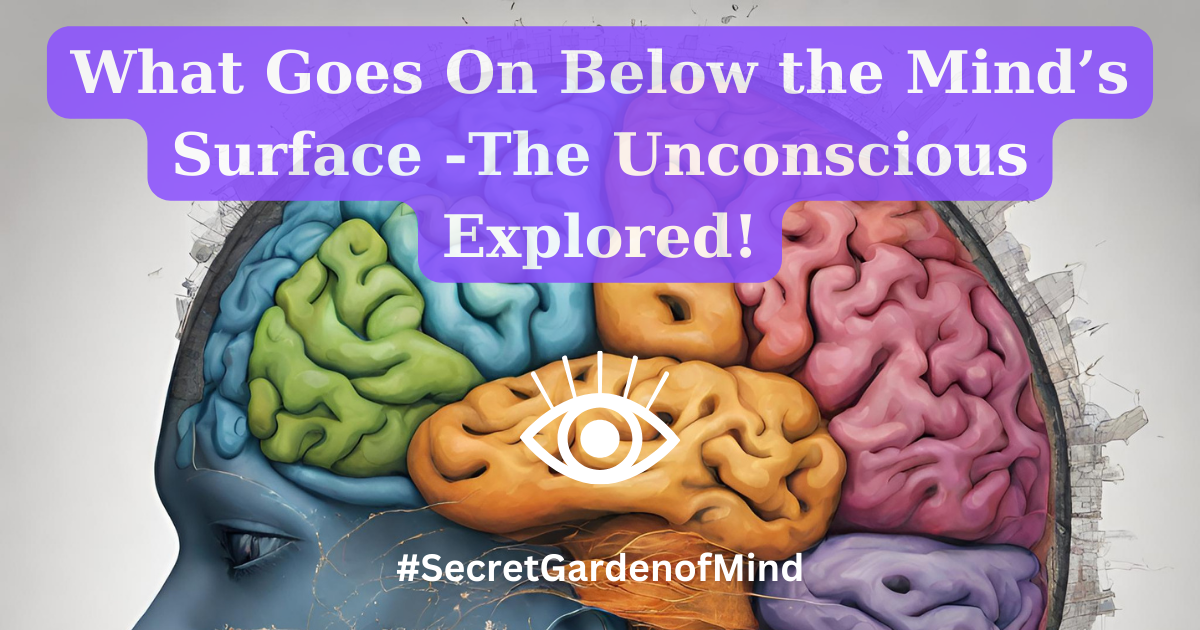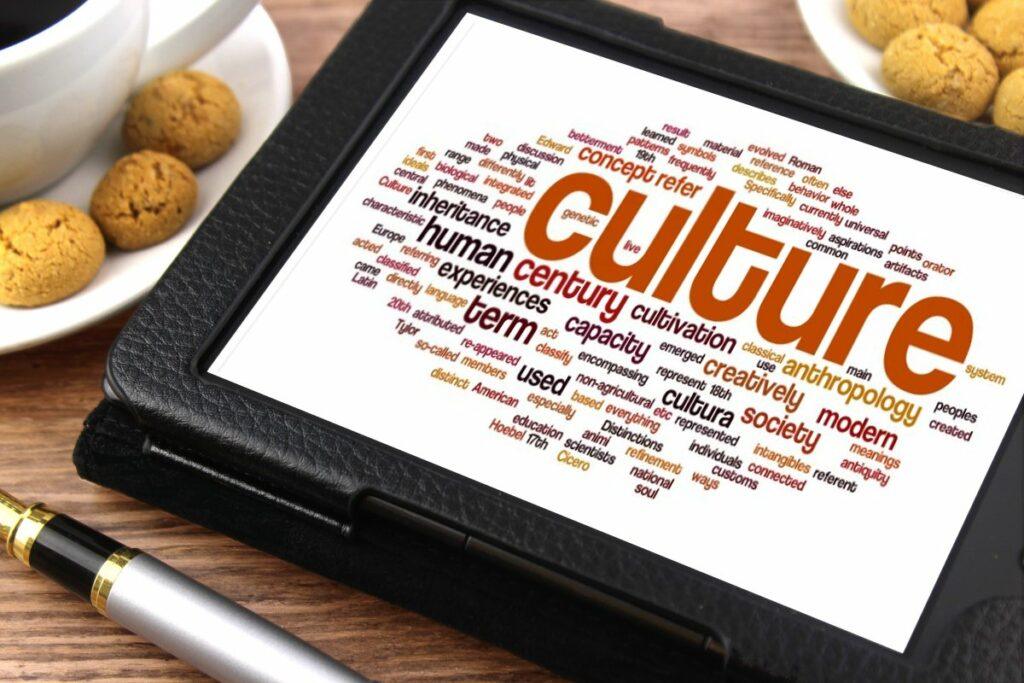What Goes On Beneath the Mind’s Surface -The Unconscious Explained!

What Goes On Beneath the Mind’s Surface is something we can really only speculate upon. The human mind is a complex and fascinating entity that has intrigued scientists, philosophers, and ordinary people for perhaps as long as we have had conscious thought.
While we may think as Individuals that we have a good understanding of how our minds work, there is still much that goes on that we are not aware of. Even without the more mystical and metaphysical aspects that people might dismiss as beyond belief we still do not know many things about what our actual minds really are.
On a biological level we can perhaps think of our mind as a CPU {Central Processing Unit) Inside one of our computers. It certainly is an Interesting idea considering other things we have in common with computers such as memory and our electrical nature. It quickly becomes very strange to think about.
In my post about Christ Consciousness I had a similar feeling writing this. Like how do I explain something so advanced, on a level that I (and I’m sure anyone else human) can barely comprehend.
It is of course something that will be purely speculative but In this blog post, we will explore some of the key aspects of the mind that shape our thoughts, emotions, and behaviour. AND from this, we shall look to examine what we can do to try and answer this lifelong question in at least some way.
What Goes On Beneath the Mind’s Surface
Different people will have different thoughts and feelings about this. How the inner mechanisms of our thoughts manifest. It kind of really depends on how you approach this question. As we shall explore there are reasons why people can become successful as Psychologists and Therapists.
Certainly, there are some ways we can try to make sense of this question. It depends on how we look at it. What is our mind to us as the Individual? How do we shape our habits and behaviours? There is a lot we can take from this and that we can use to further understand our being.
I would love to hear people’s thoughts on this at the end of this article but for now, let’s continue.
The Unconscious Mind: What It Is and How It Works

The Unconscious Mind refers to the part of our mind that operates below our conscious awareness. It is responsible for many of our automatic thoughts, feelings, and behaviors. While we may not be aware of these processes, they still have a significant Impact on our lives.
The Unconscious Mind plays a crucial role in shaping our behavior. It is responsible for storing memories, beliefs, and experiences that influence our actions. For example, if we have a fear of spiders, it may be due to an unconscious association between spiders and danger that was formed in our past experiences.
One example of an unconscious process is priming. Priming occurs when exposure to one stimulus influences our response to another stimulus. For instance, if we are exposed to words related to elderly people (such as “wrinkles” or “gray hair”), we may walk more slowly without consciously realizing why.
This shows how our unconscious mind can influence our behavior without us even being aware of it.
Implicit biases are another example of unconscious processes. These biases are automatic associations that we hold about certain groups of people. They can influence our judgments and decisions without us consciously realizing it. Understanding the role of the unconscious mind can help us become more aware of these biases and with this information, we can work towards overcoming them.
The Role of Emotions in Shaping Our Thoughts and Actions
Emotions play a crucial role in shaping our thoughts and actions. They serve as signals that provide us with information about our environment and help us make decisions.
Emotions can be positive, such as joy and love, or negative, such as anger and fear.
The purpose of emotions is to help us survive and thrive. For example, fear alerts us to potential threats and triggers the fight-or-flight response, preparing our body to respond to danger. Similarly, joy and love promote social bonding and connection, which are essential for our well-being.
Emotions are closely intertwined with cognition or our thinking processes. They influence our attention, memory, and decision-making. For example, when we are feeling anxious, our attention tends to be focused on potential threats, making it difficult to concentrate on other tasks.
Emotions also influence our memory, as we are more likely to remember events that were emotionally charged.
Emotions also play a significant role in decision-making. Research has shown that emotions can bias our judgments and choices. For example, if we are feeling sad, we may be more likely to choose comfort foods over healthier options. Understanding the role of emotions in decision-making can help us make more informed choices that can help us to avoid being swayed in the future by our emotional responses.
The Power of Habits: How They Form and Influence Our Behavior
Habits are automatic behaviours that we perform without conscious thought. They are formed through a process called Habit Formation, which involves a cue, a routine, and a reward.
For example, if we have a habit of brushing our teeth before bed, the cue may be finishing dinner, the routine is brushing our teeth, and the reward is the feeling of cleanliness.
Habits have a significant impact on our daily lives. They allow us to conserve mental energy by automating repetitive tasks. However, not all habits are beneficial. Some habits, such as smoking or overeating, can be detrimental to our health and well-being.
Understanding how habits are formed can help us develop new, healthier habits and break old, unhealthy ones. By identifying the cues and rewards associated with our habits, we can make conscious efforts to change our routines.
For example, if we want to develop a habit of exercising regularly, we can set a specific cue, such as putting on our workout clothes as soon as we wake up, and reward ourselves with a healthy snack or a relaxing bath after each workout.
Breaking old habits can be challenging, as they are deeply ingrained in our neural pathways. However, with persistence and effort, it is possible to change our habits and create positive changes in our lives.
The Science of Memory: How We Store and Retrieve Information
Memory is the process by which we encode, store, and retrieve information. It is essential for learning, decision-making, and forming our sense of identity. There are different types of memory, including;
- sensory memory,
- short-term memory, and
- long-term memory.
- Explicit memory
- Implicit memory
Sensory memory is the initial stage of memory, where information from our senses is briefly stored. It allows us to retain information for a short period of time before it is either forgotten or transferred to short-term memory.
Short-term memory, also known as working memory, is where information is temporarily stored and manipulated. It has a limited capacity and duration. For example, when we are trying to remember a phone number, we hold it in our short-term memory until we can dial it.
Long-term memory is where information is stored for an extended period of time. It has a virtually unlimited capacity and can last a lifetime. Long-term memory is further divided into explicit (conscious) and implicit (unconscious) memory.
Explicit memory includes episodic memory (memory for specific events) and semantic memory (memory for facts and concepts). Implicit memory includes procedural memory (memory for how to do things) and priming (memory for previously encountered stimuli).
Memories are formed through a process called encoding, where information is transformed into a format that can be stored in the brain. The hippocampus, a structure in the brain, plays a crucial role in the formation of new memories. Once memories are encoded, they are stored in various regions of the brain for later retrieval.
Memory retrieval is the process of accessing stored information. It can be influenced by various factors, such as the context in which the memory was encoded and the emotional state at the time of retrieval.
Understanding how memory works can help us improve our learning and retention of information.
The Inner Dialogue: Understanding Our Self-Talk
Self-talk refers to the internal dialogue that we have with ourselves. It is the voice in our head that narrates our experiences, interprets events, and provides commentary on our thoughts and actions. Self-talk can be positive or negative, and it has a significant impact on our emotions and behaviour.
Negative self-talk can be detrimental to our well-being. It can lead to feelings of self-doubt, low self-esteem, and increased stress. For example, if we constantly tell ourselves that we are not good enough or that we will fail, we are more likely to feel anxious and avoid taking risks.
Positive self-talk, on the other hand, can boost our confidence, motivation, and resilience. It involves replacing negative thoughts with positive and encouraging ones.
For example, instead of telling ourselves that we will fail, we can remind ourselves of past successes and focus on our strengths.
Changing negative self-talk can be challenging, as it often becomes ingrained in our thought patterns. However, with practice and awareness, it is possible to develop a more positive and supportive inner dialogue.
Strategies for changing negative self-talk include challenging negative thoughts, reframing negative experiences, and practicing self-compassion.
The Impact of Trauma on the Mind and Body
Trauma refers to an event or series of events that are deeply distressing or disturbing. It can have a profound impact on the mind and body, leading to a range of psychological and physical symptoms.
Trauma can affect the brain in various ways. It can disrupt the normal functioning of the amygdala, the part of the brain responsible for processing emotions and detecting threats. This can result in heightened anxiety and hypervigilance.
Trauma can also impair the prefrontal cortex, which is involved in decision-making and impulse control. This can lead to difficulties in regulating emotions and behaviour.
In addition to its impact on the brain, trauma can also affect the body. It can lead to increased levels of stress hormones, such as cortisol, which can have long-term effects on physical health.
Trauma survivors may experience a range of physical symptoms, including headaches, digestive issues, and chronic pain.
Healing from trauma involves addressing both the psychological and physical effects. Therapy, such as trauma-focused cognitive-behavioral therapy (TFCBT), can help individuals process their traumatic experiences and develop coping strategies.
Other strategies for healing from trauma include self-care practices, such as exercise and relaxation techniques, and building a support network of trusted individuals.
The Connection Between Mind and Body: How Our Thoughts Affect Our Health
The mind-body connection (the Gut-Brain Axis) refers to the relationship between our thoughts, emotions, and physical health. Research has shown that our mental state can have a significant impact on our physical well-being.
Stress is one good example. When we are stressed, our body releases stress hormones, such as cortisol, which can have a range of negative effects on our health. Chronic stress has been linked to a variety of health problems, including heart disease, diabetes, and immune system dysfunction.
On the other hand, positive emotions and thoughts can have a beneficial effect on our health. Research has shown that individuals with a positive outlook tend to have better physical health outcomes, such as lower blood pressure and reduced risk of chronic diseases.
Strategies for improving our mental and physical health include stress management techniques, such as mindfulness and relaxation exercises. Engaging in regular physical activity, eating a balanced diet, and getting enough sleep are also important for maintaining overall well-being.
The Role of Dreams in Processing Emotions and Experiences
Dreams are a natural part of the sleep cycle and occur during the rapid eye movement (REM) stage of sleep. They involve a series of images, thoughts, and emotions that can be vivid and intense.
The purpose of dreaming is still not fully understood, but research suggests that it plays a role in processing emotions and experiences. Dreams can provide a safe space for us to explore and process difficult emotions, such as fear or sadness.
They can also help us make sense of our experiences and integrate new information into our existing knowledge.
There are different types of dreams, including ordinary dreams, lucid dreams, and nightmares. Ordinary dreams are the most common type and involve a mix of familiar and unfamiliar elements. Lucid dreams occur when we become aware that we are dreaming and can control the dream content.
Nightmares are distressing dreams that can cause fear or anxiety.
Keeping a dream journal can help us gain insight into our dreams and their meaning. By recording our dreams upon waking, we can identify recurring themes or symbols and explore their significance. Dream analysis can be a valuable tool for self-reflection and personal growth.
The Influence of Culture and Society on Our Thoughts and Beliefs

Culture and society play a significant role in shaping our thoughts, beliefs, and values. They provide us with a framework for understanding the world and guide our behaviour.
Culture refers to the shared beliefs, customs, and practices of a particular group of people.
It includes elements such as language, religion, and social norms.
Culture provides us with a sense of identity and belonging and shapes our worldview.
Society refers to the larger social structure in which we live. It includes institutions such as family, education, and government. Society influences our thoughts and beliefs through socialization, which is the process by which we learn the norms and values of our culture.
Challenging cultural and societal norms can be difficult, as they are deeply ingrained in our beliefs and behaviors. However, it is important to critically examine these norms and question their validity.
By doing so, we can develop a more inclusive and compassionate worldview.
The Potential of Mindfulness and Meditation in Harnessing the Power of the Mind
Mindfulness and meditation are practices that involve paying attention to the present moment with an attitude of openness and non-judgment. This practice has been shown to have numerous benefits for mental and physical well-being, but it is always believed to be especially helpful to unlocking the minds true powers.
Mindfulness involves bringing our attention to the present moment and observing our thoughts, emotions, and sensations without judgment. It can help us become more aware of our thoughts and emotions, allowing us to respond to them in a more skillful way.
Meditation involves focusing our attention on a specific object, such as the breath or a mantra.
It can help us cultivate a sense of calm and relaxation, reduce stress, and improve concentration.
Both mindfulness and meditation have been shown to have a range of benefits, including reduced anxiety and depression, improved emotional regulation, and increased resilience.
They can also enhance our ability to focus and make better decisions.
Incorporating mindfulness and meditation into our daily lives can be done through various practices, such as;
- mindful breathing exercises,
- body scans, or
- guided meditations.
Starting with short periods of practice and gradually increasing the duration can help us develop a regular mindfulness or meditation routine. YouTube is a good resource for this but if you’d like to try a short course check out this<<
In Conclusion
Concluding this exploration of What Goes On Beneath The Mind’s Surface – The mind is a powerful tool that shapes our thoughts, emotions, and behaviour. By understanding what goes on here we can gain greater insight into ourselves and others, and make positive changes in our lives.
This can be through mindfulness, therapy, or other strategies, there are many ways to harness the power of the mind and live a more fulfilling life.
But what really goes on beyond this one can only speculate. I shall finish this article up here but if you have anything you’d like to share regarding this please do so in the comments below.


amazon bean products bean products accent pillows bean products bean bags bean products bed pillows bean products bolster bean products chicago bean products coupon code bean products decorative accent pillows bean products shredded foam bean products usa bean products yoga bean products zafu benefits of meditation for adhd best type of meditation for adhd buddhist meditation for adhd Dream Diaries Dream Master energy healing how to lucid dream Law of Attraction Laxman innertainment Light and Sound Machine Light and Sound Meditation Mind Machine lucid dream herbs Manifestation meditation meditation alzheimer meditation alzheimer prevention meditation alzheimers meditation classes adhd meditation cure adhd meditation dementia meditation for adhd adults meditation for adults with adhd meditation for memory loss meditation memory meditation memory loss Mindplace Procyon mr bean new products pre dementia reiki dementia remote viewing amplifier remote viewing baby monitor remote viewing books pdf remote viewing experiments








